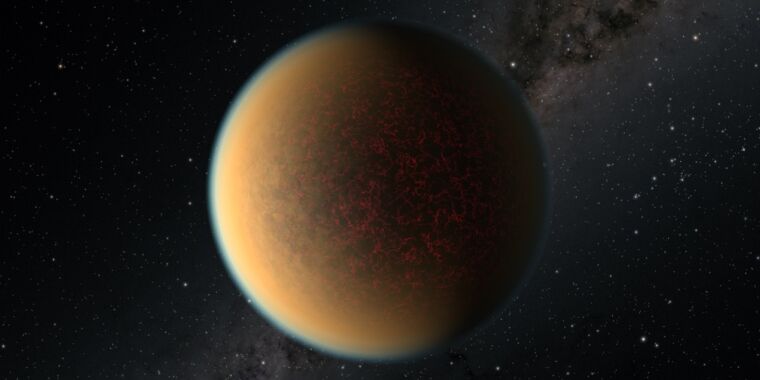

The atmosphere with which most planets begin is often not the same as the one with which they end. Most of the gas present in the formation of a solar system is hydrogen and helium. But if you look through the rocky planets of our solar system, you see three very different atmospheres (and a very faint one), with hydrogen and helium being relatively small components. And if we are given the opportunity to look at the atmospheres of exoplanets, we should get a better perspective on all the ways atmospheres can change as their planets age.
This week, an international team of astronomers reported that they had found an atmosphere on a planet where one was not expected to exist. And the astronomers suggest it is actually the planet’s second atmosphere, generated by volcanic activity after the first boiled off early in the planet’s history.
Imaging atmospheres
In general, we don’t currently have the technology to image exoplanets unless they are very large, very young, and at a considerable distance from the star they orbit. Yet we can still get a sense of what’s going on in their atmosphere. To do that, we need to observe a planet running along the line of sight between the Earth and its star. During a transit, a small percentage of the star’s light will travel through the planet’s atmosphere on its way to Earth, interacting with the molecules present there.
Those molecules leave a signature on the spectrum of light that reaches Earth. It’s an extremely vague signature, as most of the star’s light doesn’t even see the atmosphere. But by combining the data from a number of observation days, it is possible to distinguish this signature from the noise.
That’s what scientists have done with GJ 1132 b, an extrasolar planet orbiting a small star about 40 light-years from Earth. The planet is about the size of the Earth and about 1.5 times its mass. It also orbits extremely close to its host star, completing a full orbit in just 1.6 days. That’s close enough to ensure that, despite its small, faint star, the GJ 1132 b is extremely hot.
It’s so close and hot that the researchers estimate it is currently losing about 10,000 kilograms of atmosphere per second. Because the host star was expected to be brighter early in its history, the researchers estimated that GJ 1132 b would have lost a reasonably sized atmosphere within the first 100 million years of its existence. In fact, over the planet’s lifetime, the researchers estimated that it could have lost an atmosphere roughly five times the mass of the planet’s current mass – the kind of thing you could see if the surviving planet was the core of a mini Neptune. .
(There are some uncertainties in these numbers, based on how often its star emits high-energy particles and how strong the planet’s magnetic field is. But they are not large enough to hold an atmosphere in place for the entire planet of 5 billion years of history.)
So researchers were probably surprised to find that, based on data from Hubble, the planet appears to have an atmosphere.
How did that get here?
One possible explanation for this is that the planet formed at a cooler distance from the star and then migrated inward. But that would mean we captured GJ 1132 b in a relatively narrow time window: between reaching close enough to the star to lose its atmosphere, but before all that atmosphere in space had warmed up. The planet is more likely to have formed near where it is and generated a second atmosphere after the first was lost.
Fortunately, the data provided by Hubble could give some idea of what’s in the atmosphere. The signature that the molecules in the atmosphere leave on the starlight gives an indication of what they could be. These indications are complicated – as there are many molecules with signatures that partially overlap in some areas of the spectrum, but not others – and they create complications. But it is possible to look at the signal from the planet’s atmosphere and identify combinations of molecules that are compatible with that signal.
The researchers discover that there are probably some aerosols in the atmosphere. And its composition really wouldn’t be surprising on another planet: mainly methane, ethane, hydrogen and hydrogen cyanide. But remember, the whole reason this atmosphere is interesting is because the planet should have lost its atmosphere early in its history – and all of the hydrogen should have disappeared with it.
Magma
However, the research team suggests a possible solution to this conundrum. Early in the planet’s history, it should have had both a hydrogen-rich atmosphere and a surface that was a magma ocean. Recent studies have suggested that a large amount of hydrogen could potentially be stored in magma and, as the planet cools, become trapped under the crust.
But may not be caught forever. The astronomers suggest the planet should be hot, partly because of the large amounts of radiation it is picking up from its extremely nearby star, but also because of the tidal forces exerted by the star’s gravity on its crust. This should be enough to keep the crust thin and flexible, allowing for large-scale volcanism. Thus, they suggest that the current atmosphere could be formed and supplemented by volcanic activity, with hydrogen-rich magma creating its distinct composition.
Obviously, that won’t be the easiest to confirm, although the arrival of the James Webb Space Telescope will open up new regions of the spectrum to provide independent control over the estimated composition of the atmosphere. But the best control is simply to discover that this kind of secondary atmosphere appears on other exoplanets. And given the interest in mapping their atmospheres, we may not have to wait long for that.
The arXiv. Abstract number: 2103.05657 (About the arXiv). To be published in The Astronomical Journal.